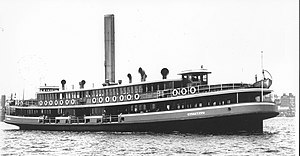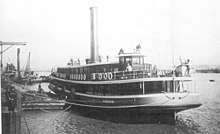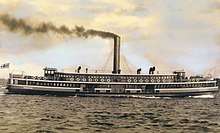HMAS Kuttabul (ship)
HMAS Kuttabul, formerly SS Kuttabul, was a Royal Australian Navy depot ship, converted from a Sydney Ferries Limited ferry.
 Kuttabul as built. 1922 | |
| History | |
|---|---|
| Name: | Kuttabul |
| Namesake: | Aboriginal word meaning wonderful |
| Owner: | Sydney Ferries Limited |
| Port of registry: | Sydney |
| Route: | Circular Quay-Milsons Point |
| Builder: | Walsh Island Dockyard and Engineering Works, Newcastle |
| Yard number: | 54 |
| In service: | 1922 |
| Out of service: | 1940 |
| Name: | HMAS Kuttabul |
| Owner: | Royal Australian Navy |
| Acquired: | 7 November 1940 |
| Commissioned: | 26 February 1941 |
| Identification: | O/N 150185 |
| Fate: | Sunk 1 June 1942 |
| General characteristics | |
| Type: | Harbour ferry |
| Tonnage: | 447 GT |
| Length: | 183 ft (56 m) |
| Beam: | 36.9 ft (11.2 m) |
| Capacity: | 2,250 |
Kuttabul and her identical sistership, Koompartoo, were the largest and last K-class ferries built. Kuttabul had the highest passenger carrying capacity of any ferry on Sydney Harbour and was ordered for the crowded Milsons Point to Circular Quay route.
During the Japanese midget submarine attack on Sydney Harbour on 31 May 1942, Kuttabul was sunk, with 21 naval personnel aboard.
Design and construction

Kuttabul originated as a steam-powered ferry, built in 1922 by the Walsh Island Dockyard and Engineering Works in Newcastle for Sydney Ferries Limited. Kuttabul was rated at 448 gross and 201 net tonnes (1269 and 569 m³), was 183 feet (56 m) long, with a beam of 36 feet (11 m), and capable of seating approximately 2,250 passengers. Kuttabul and identical sister ship Koompartoo were the largest ferries ever operated on the inner harbour ferry routes, though Kuttabul had a larger passenger capacity (2,250) than Koompartoo (2,089). Their passenger capacity was the largest ever of any ferry on Sydney Harbour, exceeding even the largest Manly ferries by 500 passengers, a record that has not been beaten by any subsequent ferry.
Both ferries were of steel construction with a wooden superstructure.[1] Both vessels were constructed with 18 watertight compartments, regarded as being unsinkable and therefore were not required to carry life-saving equipment.[2][3]
Sydney Ferries

Kuttabul spent most of its life as a double-ended Sydney suburban ferry. The ferry trade to Sydney's North Shore was increasing rapidly, and Sydney Ferries Ltd needed more and bigger boats to service the crowded Circular Quay to Milsons Point route. Prior to the opening of the Sydney Harbour Bridge, peak hour ferries were leaving either side of the harbour at the rate of one fully loaded vessel every six minutes. Kuttabul and Koompartoo were ordered specifically for the short heavy lift commuter link between across the harbour.
With the opening of the Sydney Harbour Bridge in 1932, the route became redundant. Kuttabul and Koompartoo were considered too big to be used on other routes and were laid up, but were later made available for tourist cruises on the harbour.[3][4][5] The Milsons Point wharf used by these ferries is now part of Luna Park.[6]
Royal Australian Navy and sinking
.jpg)
After the outbreak of World War II, Kuttabul was requisitioned by the Royal Australian Navy on 7 November 1940, and moored at the Garden Island naval base to provide accommodation for Allied naval personnel while they awaited transfer to their ships.[7][4]
On the night of 31 May/1 June 1942, three Ko-hyoteki class midget submarines of the Imperial Japanese Navy entered Sydney Harbour with the intention of attacking Allied warships. According to the official account, only one of the submarines, designated M-24, was able to fire her torpedoes, but both missed their intended target: the heavy cruiser USS Chicago.[4] The torpedoes, fired around 00:30, continued on to Garden Island: one ran aground harmlessly, but the other hit the breakwater against which Kuttabul and the Dutch submarine K-IX were moored.[8][9] An alternate conclusion, fortified by the contemporaneous log of the diver who found M-24 later on the day of the attack, was that Kuttabul had fallen to a five-inch shell from the Chicago.[10]:420[11] In either case, the explosion broke Kuttabul in two and sank her.[4]
The attack killed 19 Royal Australian Navy and two Royal Navy sailors asleep aboard the ferry, and wounded another 10.[12] It took several days for the bodies of the dead sailors to be recovered, with a burial ceremony held on 3 June.[13] One of the ferry's wheelhouses was salvaged and used as a naval police guardhouse at the Garden Island naval base; the base was commissioned on 1 January 1943 as the stone frigate HMAS Kuttabul in commemoration of the ferry and the lives lost.[12] The wheelhouse later came into the possession of the Australian War Memorial, and is on display alongside a composite submarine built from the wreckage of two of the Japanese midget submarines.[14]
Chronological gallery
 In her original as-built livery of varnished timber, grey hull, black funnel, and white trim
In her original as-built livery of varnished timber, grey hull, black funnel, and white trim As an excursion boat in 1937 following her 1932 removal from regular ferry service
As an excursion boat in 1937 following her 1932 removal from regular ferry service In her new post-Sydney Harbour Bridge colours, 1930s
In her new post-Sydney Harbour Bridge colours, 1930s
See also
Citations
- Prescott, Anthony (1984). Sydney Ferry Fleets. Ronald H Parsons. ISBN 0-909418-30-6.
- "The Kuttabul. New Ferry Steamer.". The Sydney Morning Herald. August 1922. Retrieved 1 May 2012.
- SS Kuttabul Ferries of Sydney
- Jenkins, Battle Surface, p. 215
- Gregory's Street Directory of Sydney & Suburbs, p. 214
- Andrews, Graeme (1975). The Ferries of Sydney. A.H. & A.W. Reed Pty Ltd. ISBN 0589071726.
- HMAS Kuttabul Royal Australian Navy
- Jenkins, Battle Surface, pp. 213–5
- Grose, A Very Rude Awakening, p. 139
- Dunhunty, Philip (2009). Never a Dull Moment. Philip Dulhunty.
- Elliott, Tim (1 April 2010). "A new twist to the midget sub attacks". The Sydney Morning Herald.
- Elbourne, Wonderful Kuttabul
- Carruthers, Japanese Submarine Raiders 1942, p. 151
- Grose, A Very Rude Awakening, pp. 253–5
References
- Carruthers, Steven (2006) [1982]. Japanese Submarine Raiders 1942: A maritime mystery (Revised ed.). Narrabeen: Casper Publications. ISBN 0-9775063-0-4.
- Elbourne, Sean (Winter 2006). "Wonderful Kuttabul – a long history of service" (PDF). Sea Talk (Winter 2006). Royal Australian Navy. pp. 11–19. Archived from the original (PDF) on 19 October 2009. Retrieved 7 September 2008.
- Gregory's Street Directory of Sydney & Suburbs (1st (reprint) ed.). 2006 [1934].
- Grose, Peter (2007). A Very Rude Awakening. Crows Nest: Allen & Unwin. ISBN 978-1-74175-219-9.
- Jenkins, David (1992). Battle Surface! Japan's Submarine War Against Australia 1942–44. Milsons Point: Random House Australia. ISBN 0-09-182638-1.
External links
